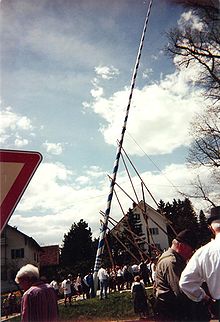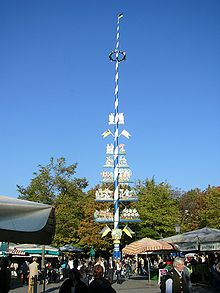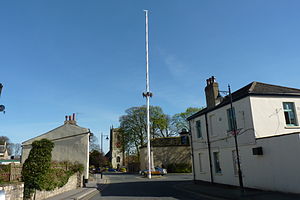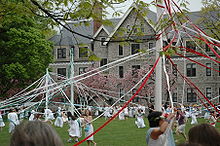- Maypole
-
A maypole is a tall wooden pole erected as a part of various European folk festivals, particularly on May Day, or Pentecost (Whitsun) although in some countries it is instead erected at Midsummer. In some cases the maypole is a permanent feature that is only utilised during the festival, although in other cases it is erected specifically for the purpose before being taken down again.
Primarily found within the nations of Germanic Europe and the neighbouring areas which they have influenced, its origins remain unknown, although it has been speculated that it originally had some importance in the Germanic paganism of Iron Age and early Medieval cultures, and that the tradition survived Christianisation, albeit losing any original meaning that it had. It has been a recorded practice in many parts of Europe throughout the Medieval and Early Modern periods, although became less popular in the 18th and 19th centuries. Today, the tradition is still observed in some parts of Europe and amongst European communities in North America.
Contents
Symbolism
The symbolism of the maypole has been continuously debated by folklorists for centuries, although no set conclusion has ever been arrived at. Some scholars classify maypoles as symbols of the world axis (axis mundi). The fact that they were found primarily in areas of Germanic Europe, where, prior to Christianisation, Germanic paganism was followed in various forms, has led to speculation that the maypoles were in some way a continuation of a Germanic pagan tradition. One theory holds that they were a remnant of the Germanic reverence for sacred trees, as there is evidence for various sacred trees and wooden pillars that were venerated by the pagans across much of Germanic Europe, including Thor's Oak and the Irminsul.[1] It is also known that, in Norse paganism, which is the best attested form of Germanic paganism, cosmological views held that the universe was a world tree, known as Yggdrasil.[2][3][4][5][6] There is therefore speculation that the maypole was in some way a continuance of this tradition.
Others have viewed them as having phallic symbolism, an idea which was purported by Thomas Hobbes, who erroneously believed that the poles dated back to the Roman worship of the god Priapus. This notion has been supported by various figures since, including the psychoanalyst Sigmund Freud. Phallic symbolism has been attributed to the maypole in the later Early Modern period, as one sexual reference is in John Cleland's controversial novel Fanny Hill:
- ...and now, disengag'd from the shirt, I saw, with wonder and surprise, what? not the play-thing of a boy, not the weapon of a man, but a maypole of so enormous a standard, that had proportions been observ'd, it must have belong'd to a young giant.[7]
The anthropologist Mircea Eliade theorizes that the maypoles were simply a part of the general rejoicing at the return of summer, and the growth of new vegetation. In this way, they bore similarities with the May Day garlands which were also a common festival practice in Britain and Ireland.[8]
Regional traditions
Germany and Austria
In Germany and Austria the maypole or Maibaum[9]) is a tradition going back to the 16th century.[10] It is a decorated tree or tree trunk that is usually erected either on 1 May – in Baden and Swabia - or on the evening before, for example, in East Frisia. In most areas, especially in Baden-Württemberg, Bavaria and Austria, it is usual to have a ceremony to erect the maypole on the village green. The custom of combining it with a village or town fete, that usually takes place on 30 April, 1 May or at Pentecost (Whitsun), is widespread. This tradition is especially strong in the villages of the Bavarian Alps where the raising of the traditional maypole on 1 May in the village square is a cause for much celebration. The pole is usually painted in the Bavarian colours of white and blue and decorated with emblems depicting local crafts and industry.[citation needed]
Just before the Maibaum is erected, depending on the region, there may be a procession through the village, usually ending up at a central place and/or restaurant and usually watched by crowds of spectators and accompanied by a brass band. The actual installation of the tree then takes place in the afternoon or evening. While the crowds usually while away the time drinking beer and eating sausages, the young men busy themselves with decorating the maypole to get the symbols of various trades representing the region into the right position. Whilst the maypole is traditionally set up with the help of long poles, today it may sometime also be done using tractors, forklifts or even cranes. In Lower Austria ropes and ladders are used.
If the tree is erected on the eve of 1 May, then the event is usually followed by a May dance or Tanz in den Mai.
Depending on local custom, the Maibaum may remain in place until the end of the month and is then taken down, decorations removed and the trunk stored until the following year. In many parts of Bavaria it remains in place all year round.
On the night of the last day of April, many young men erect small decorated "Maibäume" in front of the houses of their sweethearts. Some attach a red heart with the name of the girl written on it to the tree.
In Denmark the maypole tradition is almost extinct but is still observed on the islands of Avernakø and Strynø south of Funen and in a few villages in southern Himmerland in eastern Jutland. The maypole is generally referred to as a majtræ, "May tree".[citation needed]
In Sweden and Swedish speaking parts of Finland, the maypole is usually called a midsummer pole, midsommarstång, as it appears at the Midsummer celebrations, although the literal translation majstång also occurs. The traditions surrounding the maypoles vary locally, as does the design of the poles, although the design featuring a cross and two rings is most common nowadays. A perhaps more original incarnation is the one still in use in the Swedish landscape of Småland where the pole carries a large horizontally suspended ring around it, hanging from ropes attached at the top of the pole. This perhaps more original form of course strongly reinforces the procreation symbolism. The cross-arm may be a latter-day attempt to Christianize the pagan symbol into the semblance of a cross, although not completely successful. Common in all of Sweden are traditional ring dances, mostly in the form of dances where you are alternating dancing and making movements and gestures based on the songs, such as pretending that you are scrubbing laundry while singing about washing, or jumping as frogs during the song Små grodorna ("The little frogs"). The ring dancing is mostly popular with small children. The central part played by young children in the celebration emphasize the procreation aspect of the celebration. Yet another pointer in this direction is the custom that young maidens expect to dream of their future mate if they pick seven different flowers and place them under their pillow when they go to bed on this day only.[citation needed]
Britain and Ireland
In Britain and Ireland, the maypole was found primarily in England and in areas of Wales, Scotland and Ireland which were under English influence. Although the earliest recorded evidence comes from a Welsh poem written by Gryffydd ap Adda ap Dafydd in the mid-14th century, in which he described how people used a tall birch pole at Llanidloes, central Wales.[11] Literary evidence for maypole use across much of Britain increases in later decades, and "by the period 1350-1400 the custom was well established across southern Britain, in town and country and in both Welsh-speaking and English-speaking areas."[11]
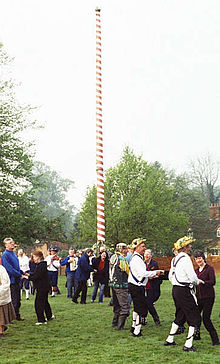 Villagers and Morris-men dancing beside the Maypole on Ickwell Green, Bedfordshire at dawn on 1st May 2005
Villagers and Morris-men dancing beside the Maypole on Ickwell Green, Bedfordshire at dawn on 1st May 2005
The practice had become increasingly popular throughout the ensuing centuries, with the maypoles becoming "communal symbols" that brought the local community together - in some cases, poorer parishes would join up with neighbouring ones in order to obtain and erect one, whilst in other cases, such as in Hertfordshire in 1602 and Warwickshire in 1639, people stole the poles of neighbouring communities, leading to violence. In some cases the wood for the pole was obtained illegally, for instance in 1603, the earl of Huntingdon was angered when trees were removed from his estates for use as maypoles without his permission.[12]
The maypole at Barwick-in-Elmet, Yorkshire, which is lowered, refurbished and raised every three years.
The rise of Protestantism in the 16th century led to increasing disapproval of maypoles and other May Day practices from various Protestants who viewed them as idolatry and therefore immoral. Under the reign of Edward VI in England and Wales, the Protestant Anglicanism was declared to be the state religion, and under the Reformation many maypoles, such as the famous Cornhill maypole of London, were destroyed, however when Mary I ascended the throne after Edward's death, she reinstated Roman Catholicism as the state faith, and the practice of maypoles was reinstated. Under later English monarchs, the practice was sporadic, being banned in certain areas, such as Doncaster, Canterbury and Bristol, but continuing in many others, according to the wishes of the local governors. In Scotland meanwhile, which at this time was still an independent state, Protestantism, in the form of Presbyterianism, had taken a more powerful hold, and largely wiped out the practice of maypoles across the country.[13]
That royal support contributed to the outlawing of maypole displays and dancing during the English Interregnum. The Long Parliament's ordinance of 1644 described maypoles as "a Heathenish vanity, generally abused to superstition and wickedness."[14] The only recorded breach of the Long Parliament's prohibition was in 1655 in Henley-in-Arden, where local officials stopped the erection of maypoles for traditional games. Scholars suspect, but have no way to prove, that the lack of such records indicates official connivance in flouting of the prohibition. However, they are certain that the prohibition turned maypole dancing into a symbol of resistance to the Long Parliament and to the republic that followed it.[15]
 May Day celebrations, banned under the Commonwealth, were revived in 1660. The maypole at Castle Bytham, Lincolnshire, was inscribed to commemorate the date when it was later cut in half for use as a ladder
May Day celebrations, banned under the Commonwealth, were revived in 1660. The maypole at Castle Bytham, Lincolnshire, was inscribed to commemorate the date when it was later cut in half for use as a ladder
When the Restoration occurred in 1660, common people in London, in particular, put up maypoles "at every crossway," according to Aubrey. The largest was in the Strand, near the current St Mary-le-Strand church. The maypole there was the tallest by far, reaching over a hundred and thirty feet, and it stood until being blown over by a high wind in 1672, when it was moved to Wansted in Essex and served as a mount for a telescope.[15][16]
In the countryside, may dances and maypoles appeared sporadically even during the Interregnum, but the practice was revived substantially and joyously after the Restoration. By the 19th century, the maypole had been subsumed into the symbology of "Merry England". The addition of intertwining ribbons seems to have been influenced by a combination of 19th century theatrical fashion and visionary individuals such as John Ruskin in the 19th century. Pairs of boys and girls (or men and women) stand alternately around the base of the pole, each holding the end of a ribbon. They weave in and around each other, boys going one way and girls going the other and the ribbons are woven together around the pole until the merry-makers meet at the base.
There are also more complex dances for set numbers of (practised) dancers, (the May Queen dancing troupes), involving complicated weaves and unweaves, but they are not well known today. However, such dances are performed every Mayday around the permanent Maypole at Offenham, in Worcestershire. Temporary Maypoles are usually erected on village greens and events are often supervised by local Morris dancing groups.
In some regions, a somewhat different Maypole tradition existed: the carrying of highly decorated sticks. The sticks had hoops or cross-sticks or swags attached, covered with flowers, greenery or artificial materials such as crepe paper. Children would take these hand-held poles to school on May Day morning and prizes may be awarded for the most impressive. This tradition is known as garlanding, and was a central feature of Mayday celebrations in central and southern England until the mid-19th century. After that time, it began to be replaced by formally organised school-centred celebrations. It still occurs from place to place but is invariably a reinstatement of a local custom that had lapsed decades earlier.
In 1780, Kilmarnock Council, now in East Ayrshire, paid Robert Fraser 2s. 6d. for dressing a Maypole, one of the last recorded examples of the rural festival of the first of May in Scotland, having been put down by Act of Parliament immediately after the Reformation in 1560.[17]
The tallest maypoles in Britain may be found in the villages of Nun Monkton, North Yorkshire (88 ft),[18] Barwick-in-Elmet, West Yorkshire (86 ft),[19] and Welford-on-Avon, Warwickshire (65 ft).
United States
While not celebrated among the general public in the United States today, a Maypole Dance nearly identical to that celebrated in the United Kingdom is an important part of many Secondary or High School dances as part of a May Day celebration. Often the Maypole dance will be accompanied by other dances as part of a presentation to the public.
The earliest use of the Maypole in America occurred in 1628, where William Bradford, governor of New Plymouth, wrote of an incident where a number of servants, together with the aid of an agent, broke free from their indentured service to create their own colony, setting up a maypole in the center of the settlement, and behaving in such a way as to receive the scorn and disapproval of the nearby colonies, as well as an official officer of the king, bearing patent for the state of Massachusetts. Bradford writes:
"They also set up a May-pole, drinking and dancing about it many days togaether, inviting the Indean women, for their consorts, dancing and frisking togither, (like so many fairies, or furies rather,) and worse practises. As if they had anew revived & celebrated the feasts of ye Roman Goddes Flora, or ye beasly practieses of ye madd Bacchinalians. Morton likwise (to shew his poetrie) composed sundry rimes & verses, some tending to lasciviousnes, and others to ye detraction & scandall of some persons, which he affixed to this idle or idoll May-polle. They chainged allso the name of their place, and in stead of calling it Mounte Wollaston, they call it Merie-mounte, as if this joylity would have lasted ever. But this continued not long, for after Morton was sent for England, shortly after came over that worthy gentleman, Mr. John Indecott, who brought a patent under ye broad seall, for ye governmente of ye Massachusets, who visiting those parts caused ye May-polle to be cutt downe, and rebuked them for their profannes, and admonished them to looke ther should be better walking; so they now, or others, changed ye name of their place againe, and called it Mounte-Dagon."[20]
See also
References
- ^ A History of Pagan Europe by Prudence Jones and Nigel Pennick, Routledge, 1997, ISBN 0415158044, 9780415158046, page 119
- ^ 'The London quarterly review, Volumes 113-114', Theodore Foster, 1863, page 117
- ^ 'The History of Religions' By Hopkins Edward Washburn, The McMillan Company 1929, page 166
- ^ European paganism: the realities of cult from antiquity to the Middle Ages by Ken Dowden, Routledge, 2000, ISBN 0415120349, 9780415120340, page 119
- ^ 'Nart sagas from the Caucasus: myths and legends from the Circassians, Abazas, Abkhaz, and Ubykhs' by John Colarusso, Princeton University Press, 2002, ISBN 0691026475, 9780691026473, page 102
- ^ 'The early history and antiquities of Freemasonry: as connected with ancient Norse guilds, and the oriental and mediæval building fraternities' by George Franklin Fort, Bradley, 1881, page 361
- ^ Cleland, John (1985). Cleland, John. Fanny Hill, or, Memoirs of a Woman of Pleasure.. New York: Penguin Classics. ISBN 0140432493. http://books.google.com/books?id=8PzitcyG2wsC&printsec=frontcover&cad=0#v=onepage&q=&f=false.
- ^ Hutton, Ronald (1996). The Stations of the Sun: A History of the Ritual Year in Britain. Oxford: Oxford University Press. Page 234.
- ^ Česky. "Maibaum – Wikipedia" (in (German)). De.wikipedia.org. http://de.wikipedia.org/wiki/Maibaum. Retrieved 2010-06-24.
- ^ Steves, Rick (2008). Rick Steves' Germany and Austria 2008. Avalon Travel. p. 45. ISBN 159880135X. http://books.google.com/books?id=pBlPaWd89J4C&pg=PA45&dq=Maypole+tradition+in+Bavaria#v=onepage&q=Maypole%20tradition%20in%20Bavaria&f=false.
- ^ a b Hutton, Ronald (1996). The Stations of the Sun: A History of the Ritual Year in Britain. Oxford: Oxford University Press. Page 233.
- ^ Hutton, Ronald (1996). The Stations of the Sun: A History of the Ritual Year in Britain. Oxford: Oxford University Press. Page 235.
- ^ Hutton, Ronald (1996). The Stations of the Sun: A History of the Ritual Year in Britain. Oxford: Oxford University Press. Page 236.
- ^ http://www.tiersma.com/STATS/LORDSDAY.HTM
- ^ a b Ronald Hutton (2001). The Stations of the Sun: a History of the Ritual Year in Britain. Oxford University Press. pp. 235–236. ISBN 0-19-285448-8.
- ^ Harvey, Paul and Dorothy Eagle, ed (1967). "Maypole in the Strand". The Oxford Companion to English Literature. Oxford: Oxford University Press. pp. 528–529.
- ^ Paterson, James (1863–1866). History of the Counties of Ayr and Wigton. Edinburgh: J. Stillie. p. 395.
- ^ Harrogate Borough Council. "Nun Monkton Conservation Area Character Appraisal". Harrogate Borough Council. http://www.harrogate.gov.uk/pdf/DS-P-CAA_NunMonkton_091209_B.pdf. Retrieved 9 December 2009.
- ^ Smith, Harold. "The Maypole". Barwick-in-Elmet Historical Society. http://www.barwickinelmethistoricalsociety.com/maypole.html.
- ^ Bradford, William (1856). History of Plymouth. Boston: Little, Brown and Company. pp. 237–238. http://books.google.com/books?id=OzMTAAAAYAAJ&printsec=frontcover#v=onepage&q&f=false.
External links
- Photos of a traditional installation of a Maypole in a Bavarian village.
- Barwick-in-Elmet Maypole Trust A triennial maypole festival held in the village of Barwick-in-Elmet, West Yorkshire.
Anglo-Saxon paganism and mythology Gods and divine figures Heroic figures Other beings Locations Sources Origins Society and culture Neopagan revival Categories:
Wikimedia Foundation. 2010.


